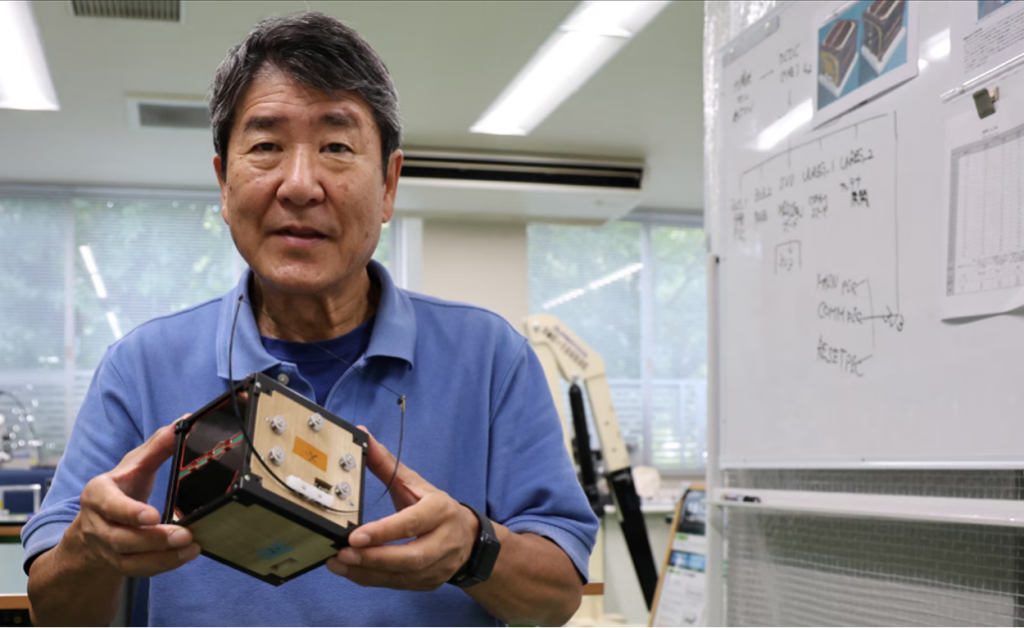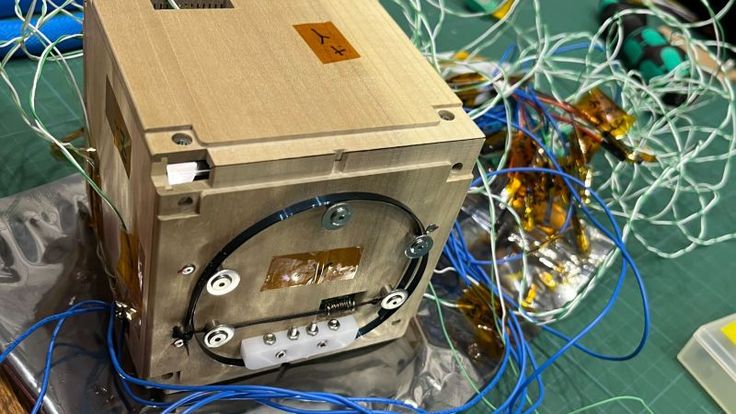World’s First Wooden Satellite Successfully Launched into Space
The launch of the world’s first wooden satellite, LignoSat, represents a significant advancement in sustainable space technology. Developed by Kyoto University and Sumitomo Forestry, the satellite aims to reduce space junk and environmental impact by burning up harmlessly on re-entry. This innovation could lead to a future where non-metallic satellites are widely adopted to protect our planet from hazardous debris.
Summary
- First-ever wooden satellite, called LignoSat, has been launched into space.
- Developed by Kyoto University and Sumitomo Forestry to combat space junk.
- Wooden structure aims to burn up cleanly in the Earth’s atmosphere.
- Launched from NASA’s Kennedy Space Center in Florida using a SpaceX rocket.
- The satellite’s dimensions are compact, measuring only 10cm on each side.
- Expected to arrive at the ISS and then be deployed into space.
- Data collected will reveal how well wood withstands extreme temperatures in space.
- The satellite will test the durability and effectiveness of using wood in satellites.
- Designed to minimize the release of metallic particles into the atmosphere.
- Research could revolutionize satellite technology, prioritizing eco-friendly materials.
- Future wooden satellites could be safer for the Earth’s environment.
- Expert astronaut Takao Doi is a key proponent of the wooden satellite concept.
- Satellite design focused on withstanding significant thermal fluctuations.
- Highlights the potential for new sustainable practices in space exploration.
- Could set a precedent for more environmentally-friendly satellites in orbit.
The Advent of LignoSat: A Revolutionary Step in Space Sustainability
Space exploration has long fascinated humanity, yet it has also contributed to a growing problem: space junk. Thousands of defunct satellites and metal fragments orbit our planet, posing a hazard to future space missions and potentially harming Earth’s atmosphere when they eventually re-enter. The world’s first wooden satellite, LignoSat, could change all that.
Developed by Kyoto University in partnership with Sumitomo Forestry, this groundbreaking satellite aims to solve a pressing environmental issue. As Takao Doi, an astronaut and professor at Kyoto University, puts it, “Satellites that are not made of metal should become mainstream.” Let’s delve deeper into what makes LignoSat so unique and what it could mean for the future of space technology.
The concept of using wood in satellites may sound unusual, but it has compelling scientific backing. Kyoto University and Sumitomo Forestry have been investigating how wooden materials could offer a practical, environmentally safe alternative to traditional satellite construction.
- Why Wood?
- Wood is a renewable, biodegradable material.
- It does not generate harmful debris when it burns up upon re-entry.
- LignoSat uses a special type of timber designed to endure the harsh environment of space.
- Key Goals of the Mission
- Test whether wooden satellites can withstand extreme conditions in space.
- Study how the satellite reacts to rapid temperature changes and microgravity.
- Determine the practicality of using wood as a material for future satellites.
The Launch: From Earth to Orbit
The LignoSat satellite launched aboard a SpaceX Falcon 9 rocket from NASA’s Kennedy Space Center in Florida. The rocket carried the satellite to the International Space Station (ISS), where it will remain in a secure container until it is deployed into outer space. This collaboration showcases the power of international partnerships in space exploration.
Table 1: Key Launch Details
| Parameter | Details |
|---|---|
| Launch Vehicle | SpaceX Falcon 9 |
| Launch Site | NASA’s Kennedy Space Center |
| Satellite Name | LignoSat |
| Satellite Size | 10cm x 10cm x 10cm |
| Developed By | Kyoto University & Sumitomo Forestry |
| Objective | Test wooden material durability |
The primary focus of LignoSat is to determine whether wood can endure the challenges of space. While metal satellites can survive in space for years, they leave metallic debris when they re-enter the atmosphere. These particles may interfere with telecommunications and have lasting environmental effects.
-
Temperature Fluctuations
- In space, temperatures can swing between -250°F and 250°F.
- The satellite will monitor how well the wooden panels withstand these conditions.
-
Durability and Data Collection
- LignoSat is equipped with sensors to transmit data back to researchers.
- The goal is to assess the wood’s structural integrity and any signs of warping or damage.
The Role of Takao Doi
Takao Doi, a veteran astronaut and special professor at Kyoto University, has been a leading advocate for LignoSat. His work reflects a deep commitment to advancing sustainable space technology.
Doi’s experience in space exploration gives him a unique perspective on the challenges of operating satellites. He believes that wooden satellites could be a game-changer in reducing the environmental impact of future missions.

Challenges and Potential Risks
-
Thermal Expansion and Contraction
- One of the main concerns is how wood will behave when exposed to severe temperature shifts.
- Wooden materials could potentially expand or contract, affecting the satellite’s performance.
-
Micrometeoroid Impact
- Space is filled with small debris particles that could damage the satellite.
- The satellite’s wooden structure must be robust enough to withstand minor impacts.
-
Space Radiation
- Radiation can weaken or degrade materials over time.
- Researchers are interested in whether wood can maintain its integrity in this harsh environment.
Table 2: Challenges and Considerations for Wooden Satellites
| Challenge | Potential Impact |
|---|---|
| Extreme Temperatures | Material warping or cracking |
| Micrometeoroid Impacts | Structural damage |
| Space Radiation | Material degradation |
| Long-term Exposure | Possible weakening of wood fibers |
The Future of Wooden Satellites
If LignoSat proves successful, it could open the door to a future where eco-friendly satellites become the standard. Here’s how this innovation might evolve:
-
Mass Production of Wooden Satellites
- Companies could adopt sustainable materials for constructing satellites.
- Wooden satellites may become more common, especially for short-term missions.
-
Reduced Space Debris
- A shift from metal to wood could significantly decrease the amount of space junk.
- Future re-entries could be safer for Earth’s atmosphere.
-
Enhanced Sustainability
- The project aligns with global efforts to combat climate change by reducing the environmental impact of human activities.
Facts About LignoSat
- The wood used for LignoSat is specially treated to resist decay and damage.
- This is the first time a natural material has been tested on this scale in space.
- If successful, LignoSat could inspire other industries to explore renewable materials in advanced technology.
- The concept of a wooden satellite was inspired by traditional Japanese woodworking techniques.


